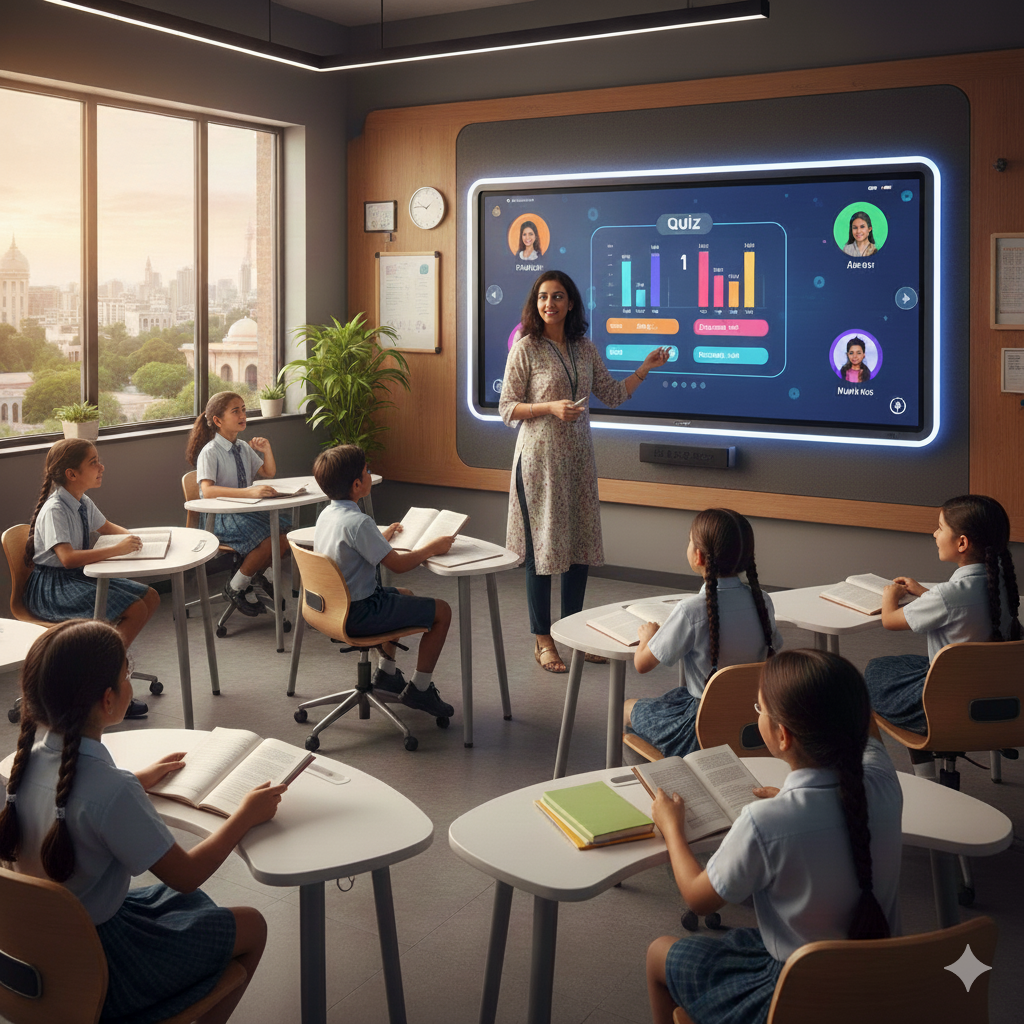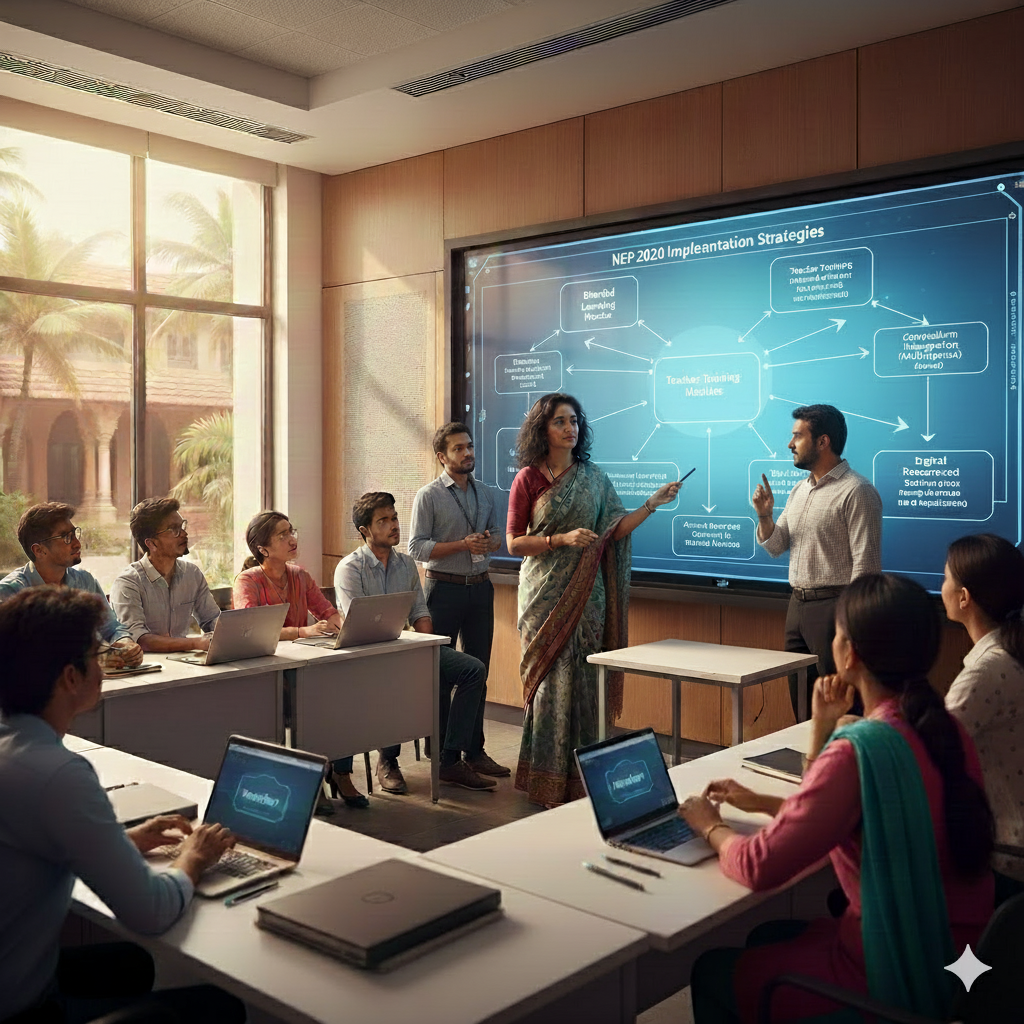How to Blend In-Person and Online Learning in a Hybrid Classroom
.jpg)
The future of education is here, and it's called hybrid learning! We understand the growing demand for a seamless blend of in-person and online education. Whether you’re a principal balancing new challenges, a teacher adapting lesson plans, or a parent supporting your child’s education, navigating this hybrid classroom model might seem daunting, but we're here to walk you through it.
At its core, a hybrid digital classroom combines the strengths of traditional face-to-face interaction with the flexibility offered by online education. This approach goes beyond simply adapting to current trends. It aims to establish a more versatile and engaging learning environment for all participants.
Let us explore how to effectively integrate these two modes of education and understand why hybrid classrooms represent the future of learning.
The Evolution of Hybrid Classrooms

The COVID-19 pandemic accelerated the adoption of digital learning, prompting institutions to transition to online education almost overnight. Now, with schools and universities fully reopened, it has become evident that simply returning to pre-pandemic methods is insufficient.
Hybrid learning has since established itself as a sustainable and effective approach to engaging students across virtual and physical environments. This model accommodates diverse learning needs, supports flexible schedules, and prepares students for a future where digital interaction plays a central role. But how can educators design a hybrid classroom that delivers? Let’s discuss the key factors that contribute to a successful digital classroom model and address the specific needs.
Laying the Foundation for Hybrid Classrooms
School principals and administrators play a crucial role in shaping the future of education by adopting new learning methods. Hybrid learning requires more than just installing a few computers in the classroom. It demands a complete rethinking of how education is delivered.
A successful hybrid digital classroom begins with a clear vision from leadership. Principals need to ensure that all stakeholders—teachers, parents, and students—are aligned with the school’s hybrid learning objectives. What’s the goal? Is it to offer flexible learning schedules, increase student engagement, or simply cope with unpredictable situations like school closures? Defining the intended outcomes is the first step toward building an effective hybrid model.
Key Components for Effective Hybrid Learning: Technology, Training, and Classroom Management
1. Infrastructure and Technology Investment
Hybrid learning requires a robust infrastructure that supports in-person and online education. As administrators, it’s crucial to invest in the right technology. At Roombr, our digital classroom solutions are designed specifically to bridge the gap between physical and online education. Our interactive projector and AI-driven tools facilitate seamless teaching, content sharing, and student interaction, making hybrid classrooms functional and efficient.
2. Teacher Training and Professional Development
One of the biggest challenges for school administrators is ensuring that teachers are equipped to handle hybrid classrooms. Professional development programs focusing on digital tools, online teaching strategies, and student engagement techniques are essential. Teachers need to feel confident in using new technologies and managing a dual-mode teaching environment.
Principals and administrators should embrace data-driven insights to evaluate the effectiveness of digital learning. From attendance to engagement metrics, having a real-time understanding of student performance helps make informed decisions. With Roombr’s digital classroom technology, you can easily access and analyze student data to ensure that hybrid learning benefits everyone involved.
3. Designing Lessons for Dual Delivery
In a hybrid classroom, teachers need to create lesson plans that work for in-person and online students simultaneously. This might involve blending synchronous and asynchronous learning. For example, teachers can conduct a live class for in-person students while streaming it for those online, then provide digital learning resources for students to work on at their own pace.
One approach is to incorporate flipped learning, where students engage with instructional content (videos, articles, etc.) online before the actual class. During the in-person session, teachers can focus on deeper discussions and hands-on activities.
4. Engaging All Students
Engagement is a common challenge in hybrid classrooms. Teachers must ensure that remote students are as involved as their in-person peers. Using interactive tools such as polls, quizzes, breakout rooms, and live chat features can help bridge the gap and foster real-time participation. Incorporating collaborative platforms like digital classroom boards, shared documents, and discussion forums encourages active learning and peer interaction across both settings. The goal is to create an inclusive environment where all students feel seen, heard, and involved, regardless of their location.
5. Managing Classroom Dynamics
Classroom management in a hybrid setting is another challenge. Teachers must ensure that in-person students don’t dominate the conversation, leaving online learners feeling excluded. To address this, teachers can rotate between focusing on online and in-person students, ensuring both groups receive equal attention. Using breakout rooms for online students and group work for in-person students allows teachers to manage smaller groups more effectively.
6. Assessments and Feedback
Hybrid classrooms require flexible assessment methods. Teachers should consider incorporating both formative and summative assessments, using online platforms to administer quizzes and assignments for remote students. Regular feedback is also crucial, particularly for students who might feel disconnected from the classroom. Roombr’s assessment tools help teachers track student progress and provide personalized feedback efficiently.
Hybrid learning offers students more flexibility but also requires a higher level of self-discipline. The combination of in-person and online education gives students more control over their learning, but it also demands time management and organizational skills.

The Benefits of Hybrid Learning for Students
1. Personalized Learning Experience
Digital learning allows students to tailor their education to their personal needs:
- Students who thrive in independent, self-paced environments benefit from the online components.
- Those who need more direct interaction with teachers gain support through in-person classes.
2. Future-Ready Skills
Hybrid learning also prepares students for the increasingly digital workforce. It helps them develop:
- Digital literacy
- Virtual collaboration skills
- Time management and self-discipline
3. Staying Organized
Success in a hybrid classroom requires proactive organization. Students can use tools like:
- Digital calendars
- To-do list apps
- Note-taking tools
These help students stay on top of assignments and manage their workload effectively.
4. Active Participation is Key
To succeed in a hybrid environment, students should:
- Engage actively in both in-person and online discussions
- Ask for help when needed
- Avoid falling behind by participating consistently
How to Manage the Challenges
Some students may face difficulties such as isolation or distractions at home. To overcome these:
- Set up a dedicated, distraction-free learning space
- Establish a consistent daily routine
- Limit digital interruptions during class time
Hybrid learning is a new experience, and while it may take time to adjust, students can thrive with the right strategies in place.
Steps to Support Your Child in a Hybrid Classroom
1. Create a Conducive Learning Environment at Home
Parents play a pivotal role in supporting their children’s success in a hybrid classroom. With students splitting time between online and in-person education, it’s important for parents to help create a conducive learning environment at home while staying engaged in their child’s education.
2. Ensure Access to Learning Tools
One of the challenges of digital learning is that students may not always be in a traditional classroom setting. As a parent, you can help by setting up a quiet, dedicated learning space for your child. Ensure that they have all the necessary tools—like a computer, a reliable internet connection, and school supplies—so they can stay focused during online lessons.
3. Establish a Consistent Routine
Encouraging a daily routine, even on days when your child is learning online, can help create a sense of normalcy and discipline. This routine might include scheduled breaks, time for physical activity, and designated hours for homework.
4. Stay Involved in Academic Progress
Just because your child is learning online doesn’t mean you should take a hands-off approach. Stay in touch with their teachers and monitor their progress. Roombr’s platform provides access to real-time student performance data, so you can see how your child is doing and address any issues early on.
5. Support Social and Emotional Well-Being
Hybrid learning can be isolating for students, especially during the online portion. It’s important to support your child’s emotional well-being by encouraging them to stay connected with peers through virtual study groups, clubs, or extracurricular activities. Check in regularly to see how they’re feeling about the hybrid model and if they need additional support.
How EdTech Can Support Hybrid Learning
1. Addressing the Needs of Hybrid Classrooms
EdTech companies and start-ups are key players in the successful implementation of hybrid learning. Developing products that cater to the unique needs of hybrid classrooms will ensure that schools and institutions can offer high-quality, engaging, and flexible education to their students.
2. Solving Core Challenges with Technology
EdTech professionals need to focus on solving the core challenges of digital learning: student engagement, classroom management, and assessment. Developing tools that facilitate seamless interaction between in-person and online students will help keep both groups engaged.
3. Enhancing Learning Through AI
AI-powered tools that provide personalized feedback and assessments can enhance the learning experience. Smart classroom solutions feature advanced AI integration to help teachers monitor student performance in real-time and offer tailored feedback.
4. Empowering Teachers with Better Tools
One of the key obstacles to hybrid learning is the lack of teacher readiness. EdTech professionals should focus on creating user-friendly interfaces and offering comprehensive training materials so that educators can use the tools effectively. Teachers need platforms that are intuitive and easy to navigate, without requiring extensive technical knowledge.

Conclusion
Hybrid classrooms represent the future of education, offering flexibility, inclusivity, and better engagement for students and teachers. However, achieving a seamless blend of traditional and online education requires the right tools, training, and mindset. As teachers, students, parents, and EdTech professionals, each of us plays a vital role in making hybrid learning a success.
FAQs
1. What is a hybrid classroom, and how does it differ from traditional and fully online models?
A hybrid classroom combines in-person and online learning, allowing students to participate in educational activities from both physical classrooms and virtual environments. In a traditional classroom, students are physically present for all lessons, while in a fully online model, all interactions and learning take place virtually. The hybrid model offers flexibility by integrating these two approaches, enabling students to attend classes in person or remotely, depending on their needs or circumstances.
2. What technology is essential for setting up a successful hybrid digital classroom?
Setting up a hybrid classroom requires a combination of hardware and software tools. Essential technologies include interactive projectors or digital classroom boards, reliable internet connectivity, video conferencing tools, cloud-based learning management systems (LMS), and collaboration platforms.
3. How can teachers keep online and in-person students equally engaged in a hybrid classroom?
Teachers can use interactive tools and techniques such as live polls, quizzes, breakout rooms for online students, and group activities for in-person learners to engage both groups of students. Rotating between focusing on online and in-person students ensures both receive attention.
Build an Effective Hybrid Classroom with Confidence
Ready to navigate the challenges of hybrid learning? Roombr’s smart digital solutions help you seamlessly integrate in-person and online education for better engagement and results. Request a demo and see how we can help you transform your classroom into a future-ready hybrid learning environment!
Parvin Khatun
Share
Step Into the future of
Education with Roombr












.png)





